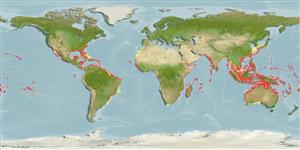Common names from other countries
Environment: milieu / climate zone / depth range / distribution range
Sinh thái học
; Thuộc về nước lợ; Mức độ sâu 0 - 70 m (Ref. 83908). Tropical
Atlantic Ocean: from the west coast of Florida, USA to the Caribbean, including Gulf of Mexico, south to Brazil, east to Canary Islands and south to São Tomé & Príncipe; Indian Ocean: from Yemen to Kwazulu Natal, South Africa, including Madagascar, Seychelles, Aldabra, east to India and south to Dampier Archipelago, Western Australia including the Andaman, Chagos Archipelago and Diego Garcia Atoll; Pacific Ocean: from Japan to the South China Sea and south to Queensland, Australia including Federated States of Micronesia, east to American Samoa.
Length at first maturity / Bộ gần gũi / Khối lượng (Trọng lượng) / Age
Maturity: Lm ? range ? - ? cm
Thallus consists of a horizontal branched stolon and feather-like erect branches. Upcurved cylindrical pinnules are pinnately or distichously arranged along the side of the distal portion of
branch axes and sometimes tristichously arranged at the lower or basal portion of the erect branches. Erect branches up to 10 cm in height (Ref. 80758).
Used for human consumption as food and medicine: antifungal, lowers blood pressure (Ref. 80758). Maximum depth from Ref. 102144. Inhabits sandy substrate with coral rocks in calm, shallow areas and moderately exposed habitats. It may form large colonies on sandy shallows, attached to shells, stones, and coral fragments or anchored on the sand. While quite able to grow luxuriantly in warm shallow tidepools or lagoons, this species is apparently not adapted to shaded habitats (Ref. 80758).
Guiry, M.D. and G.M. Guiry. 2009. (Ref. 80701)
IUCN Red List Status (Ref. 130435)
CITES status (Ref. 108899)
Not Evaluated
Not Evaluated
Threat to humans
Human uses
Các nghề cá: Tính thương mại
| FishSource |
Các công cụ
Thêm thông tin
Age/SizeSự sinh trưởngLength-weightLength-lengthHình thái họcẤu trùngSự phong phú
Các nguồn internet
Estimates based on models
Preferred temperature
(Ref.
115969): 23.4 - 29, mean 27.4 (based on 2022 cells).
